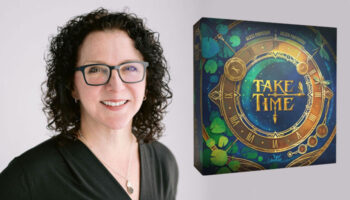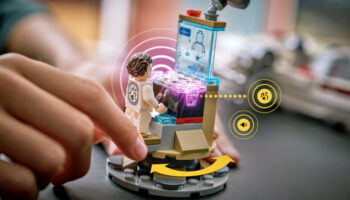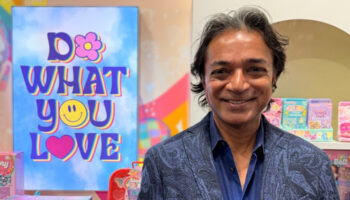Rebecca Atkinson on the origins of Mixmups – and the show’s brand potential

Rebecca, it’s lovely to catch up. Now, in case anyone is new to Mixmups, how would you describe the show?
Mixmups is a 52-part stop motion animation series about three little friends with a magic wooden spoon and a mixing box. They put objects in the box and mix up them up the create adventures. They then get sucked into the box and go on those problem-solving adventures.
Where did the idea for this come from?
It started back in 2015 when I started the ToyLikeMe campaign – it called on the global children’s industries to better represent disabled children. Change has happened since then; we’ve seen lots more diverse product come through… But what I felt was missing was something that spoke to disabled children directly from the get-go. So, rather than a brand like Barbie adding in those types of inclusive toys, I wanted something that centred on those stories and those children from the off.
Although we have diverse characters in Mixmups, the brand is really about play and the magic of imagination. It’s centred on a toyetic world where these characters live, and there’s lots of play theory baked in. We have a play consultant – Karen Newell – who used to work on Teletubbies. I’ve worked with Karen over a number of years to ensure we’re building a playful brand that appeals to all children.
What was the process like getting this off the ground?
It’s taken a long time; the best part of eight years. I have a background and TV and writing, but the first thing I did was spend a year researching play theory. That helped me put the world of Mixmups together in my mind. With kids’ TV shows, the end product looks quite simple – but it’s been through rounds and rounds and rounds of development.
I then created a bible in a box. It was basically a cardboard box full of these little pop-up books that I’d created featuring the Mixmups characters. I started sending these to TV people. I had several people who worked in TV – and who had disabled children – come forward and connect with me. One of those was Debbie Macdonald; she was the originally commissioner of Peppa Pig. Others included Alison Rayson, a distributor, and Chris Bowden of Mackinnon and Saunders, an animation studio. They all believed in the Mixmups project and supported me in getting it in front of commissioners.
We got a small grant from the BFI into Mackinnon and Saunders to develop the animatic and develop the format further. We then took that to commissioners and it was picked up very quickly by Milkshake!, Channel 5. Once it was picked up, we’re then tasked with putting together the budget – and that’s a big job. Fortunately for Mixmups there was something called the Young Audience Content Fund – that’s a fund at the BFI that funds high-quality, UK-born content for children. Unfortunately, that fund no longer exists, but they helped fund Mixmups and we also raised money through our ToyLikeMe non-profit arts organisation. It’s been like climbing a mountain, while also dragging an elephant uphill – by its tail! It’s not been easy!

A big well done on getting it made! Do you see Mixmups as a brand that thrive in consumer products – like toys – as well as on TV?
From the beginning, it was designed as a show that could go on to create toys. We worked with academics on research for Toy Like Me which showed that just three minutes of play with a toy with a wheelchair could improve the friendship intentions of non-disabled children. There was a clear imperative for making these products.
That said, I didn’t want to just do something worthy – I wanted to do something that was explosively creative. I wanted something brighter, more compelling and more toyetic than things that have existed before. I wanted to play with conventions and push things on – and that always extended to Mixmups thriving as a brand off-screen… And being built around play means Mixmups can translate easily to toys when the time is right.
When do you see the time being right? Have you had conversations with toy companies already?
It’s early days for a pre-school brand. It takes a long time to build brand awareness and make the leap into consumer products, but the show has been performing very well in the UK and will launch in other territories later this year. These things usually take several years.

Going back to the show, how did you approach introducing ideas of inclusivity in a way that feels authentic?
It’s a really good question. It’s actually quite a skill to take a subject people think of as being dry and boring, and turning it into something magical that draws people in. I’ve got a disability myself, so I’m able to tell these stories from a point of lived experience. I can handle them with a sensitivity that I don’t think a lot of other production companies would have the confidence to do.
I’ve written all 52 stories of Mixmups and, as mentioned, the brand is built around play. I wanted to find a universal thing that all children are interested in, and all children play. I also wanted to create a world that was compelling by itself, and then add in these characters with their vulnerabilities. It deepens an already compelling premise.
Why do you feel it’s taken this long for a show with this approach to land?
People have tried before, but the way we tell stories about these characters is very fresh – and that’s because it’s been led by somebody with a disability. It’s not about characters with disabilities; it’s about play and magic. There’s a balance between the two, and striking that balance doesn’t come from charity narratives or myths about disability… It comes from my team knowing how to make it funny, warm, vulnerable, human… It’s a special recipe.
And a lot of children’s TV shows that do well come from one creator; one vision. Bluey, The Clangers, Postman Pat… They come from one mind, rather than a team looking to create the next big thing. Mixmups has that human touch to it – and stopmotion also reinforces that quality.
In the wider kids’ TV landscape, are we seeing better representation around disabled characters?
We are, but we aren’t seeing disabled-led content. You can liken it to the past when people would put diverse characters into children’s content… It wasn’t until JoJo & Gran Gran, we didn’t have a children’s series from a black creator. We might’ve had black characters in the same way that there might’ve been characters using wheelchairs, but who’s telling those stories? Parents of children with diverse needs want their children to be viewed equally or celebrated. They don’t want their children to appear on screen as a learning point.
Diversity and inclusion is complex – it’s moved beyond including characters just to tick boxes. There’s now appreciation for the structures in the industry that keep those characters off-screen and diverse creators out of the sector. An acknowledgement of that is now helping more voices come through. It’s a commercial business and it’s tough to square the perception of worthiness with the commercial agendas of the industry. It continues to be a tricky balance.
Great insights there. Now, I wanted to talk toys with you. The first time we spoke was back in my time at ToyNews, covering your ToyLikeMe campaign. Have you seen a meaningful change in the toy industry with regards to disability representation?
When we launched Toy Like Me, there was hardly anything… Maybe a LEGO Minifigure of a grandad using a wheelchair. It was bad! Since then, it’s been better – and I like to think Toy Like Me played a role in raising the agenda in the toy industry. LEGO has launched Minifigures with hearing aids and prosthetic limbs. Barbie has done a plethora of diverse characters. There’s a lot more choice these days if you have a child with a disability or a medical condition and you want toys that represent them.
What’s also interesting is that they’ve become normalised. Mattel has recognised that there’s a wider market beyond those children. Today’s generation of children are broader minded and will play with a Barbie in a wheelchair – not just as part of a hospital set! When I made-over toys as part of the Toy Like Me campaign in 2015, we did a Barbie with vitiligo and put a high-res image of it online, it went viral – and you can now buy Barbies with vitiligo. We didn’t do it to get accolades, we did it to provoke change and I’m proud of what we did.

When Mixmups comes to do toys, do you know the sorts of products you’d like to launch?
I would love to see Mixmups leap off screen as a five senses brand, where every touchpoint connects to more than one sense. The toy might have tactility and a scent, or books that come with sounds. And as a brand, Mixmups has a lot of stretch to it. The mixing element could apply to arts and crafts with paint. It could apply to baking or cookbooks. You could apply it to bath play with potions and lotions.
We’ve got a modular vehicle that comes in parts and fits around a wheelchair character. That has a lot of toy potential. It’s a compelling world, with compelling characters. If you watch Mixmups, you’ll see the product potential leaping off the screen. It’s a magical show!
Rebecca, this has been great. A huge thanks again and congrats with everything you’ve built so far with Mixmups!
–
To stay in the loop with the latest news, interviews and features from the world of toy and game design, sign up to our weekly newsletter here





















